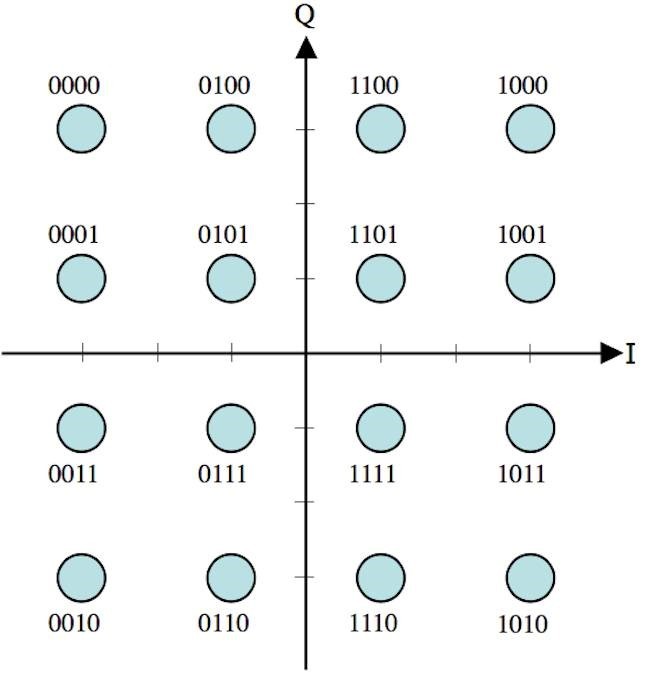250 gigabit optical cable across the Atlantic: Nokia case
Nokia has launched the transatlantic fiber optic cable for Facebook. During the test launch, the speed reached 200–250 Gbit / s for transmission over 5500 kilometers.
According to company representatives, the technology used, called PCS (Probabilistic Constellation Shaping), increased data transfer efficiency between New York and Ireland by 2.5 times.
 / photo Groman123 CC
/ photo Groman123 CC
PCS and methods for compensating for nonlinearity in the fiber made it possible to achieve a spectral efficiency of 7.46 bps per hertz with 64-QAM modulation. The word constellation (“group”) in the name of the technology is a reference to the number of states that can be represented by changes in amplitude and phase. For example, the image below shows a 16-QAM circuit:

In the particular case of modulation, the points have equal weights - all points are used with the same frequency. The PCS algorithm selects the optimal group of points that is most suitable for the channel state.
At the same time, company representatives say: “PSC rarely uses high-amplitude signal points. As a result, the transmitted signal acquires resistance to noise and interference. All this allows us to adapt the data stream and increase the translation speed by about 30%. "
Nokia showed off last yearcapabilities of its technology. Then the scientists managed to transfer data at a speed of 1 Tbit / s in the fiber-optic network Deutsche Telekom. According to experts, they almost reached the so-called Shannon border, established in 1945. The Shannon boundary is understood as the maximum transmission rate at which errors in the channel with a given signal to noise ratio can be corrected.
Nokia is convinced that in the future, PCS will allow cables to reach 32 Tbps. As says President of Nokia Bell Labs Marcus Weldon (Marcus Weldon), fiber-optic network of the future will not only ensure the rapid transfer of large amounts of data, but also dynamically adapt to the used channels and the current traffic requirements.
When this technology begins to operate in practice is unknown, but the tests, as was said, took place in "real conditions." At the same time, it is expected that it will become an integral part of the 5G protocol, the implementation of which is planned for 2020.
PS Other materials from the First Corporate IaaS Blog:
According to company representatives, the technology used, called PCS (Probabilistic Constellation Shaping), increased data transfer efficiency between New York and Ireland by 2.5 times.
 / photo Groman123 CC
/ photo Groman123 CCPCS and methods for compensating for nonlinearity in the fiber made it possible to achieve a spectral efficiency of 7.46 bps per hertz with 64-QAM modulation. The word constellation (“group”) in the name of the technology is a reference to the number of states that can be represented by changes in amplitude and phase. For example, the image below shows a 16-QAM circuit:

In the particular case of modulation, the points have equal weights - all points are used with the same frequency. The PCS algorithm selects the optimal group of points that is most suitable for the channel state.
At the same time, company representatives say: “PSC rarely uses high-amplitude signal points. As a result, the transmitted signal acquires resistance to noise and interference. All this allows us to adapt the data stream and increase the translation speed by about 30%. "
Nokia showed off last yearcapabilities of its technology. Then the scientists managed to transfer data at a speed of 1 Tbit / s in the fiber-optic network Deutsche Telekom. According to experts, they almost reached the so-called Shannon border, established in 1945. The Shannon boundary is understood as the maximum transmission rate at which errors in the channel with a given signal to noise ratio can be corrected.
Recommended reading: Our digests
Nokia is convinced that in the future, PCS will allow cables to reach 32 Tbps. As says President of Nokia Bell Labs Marcus Weldon (Marcus Weldon), fiber-optic network of the future will not only ensure the rapid transfer of large amounts of data, but also dynamically adapt to the used channels and the current traffic requirements.
When this technology begins to operate in practice is unknown, but the tests, as was said, took place in "real conditions." At the same time, it is expected that it will become an integral part of the 5G protocol, the implementation of which is planned for 2020.
PS Other materials from the First Corporate IaaS Blog:
- Southern Distribution Company: experience of using 1C SaaS in the IT-GRAD IaaS cloud for wholesale tasks
- IaaS in the world of music: how the cloud is becoming the standard for placing audio content
- vCloud Availability: a deep dive in traffic replication
- vCloud Director: how to create a secure connection between two organizations
- Pulkovo Airport: experience using the IaaS cloud for an international project and organizing a reserve site
- VMware Cloud Foundation: Simplified Data Center and Hybrid Cloud Deployment



